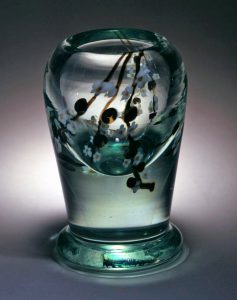The firm transformed the merely useful domestic object into something of rare beauty. This installation of art glass from the studios of Louis Comfort Tiffany (1848–1933) features examples that richly illustrate how Tiffany and his artisans mastered this medium in terms of color, form, and technique. These objects were blown into amazing shapes and formulated into brilliant, often lustrous, hues. Of endless variety, some were made with pitted textures, others were layered to produce special effects, and still others were manipulated to create undulating, mesmerizing patterns.
Tiffany art glass was inspired by an array of sources—antiquity, horticulture, rocks, the flow of lava, and, most of all, Tiffany’s own powerful imagination. Through the exploitation of chemistry, mechanics, and the logistics of production, the artist was able to translate his ideas into splendid objects of astonishing originality.
“The search for beauty is in itself the most wholesome of all quests,” Tiffany wrote in an article for Harper’s Bazaar in 1917. Tiffany’s blown-glass vessels, prestigious to own and display in an era of expanding industrial wealth, provided the artist’s crusade for beauty with a new path into the American home.



